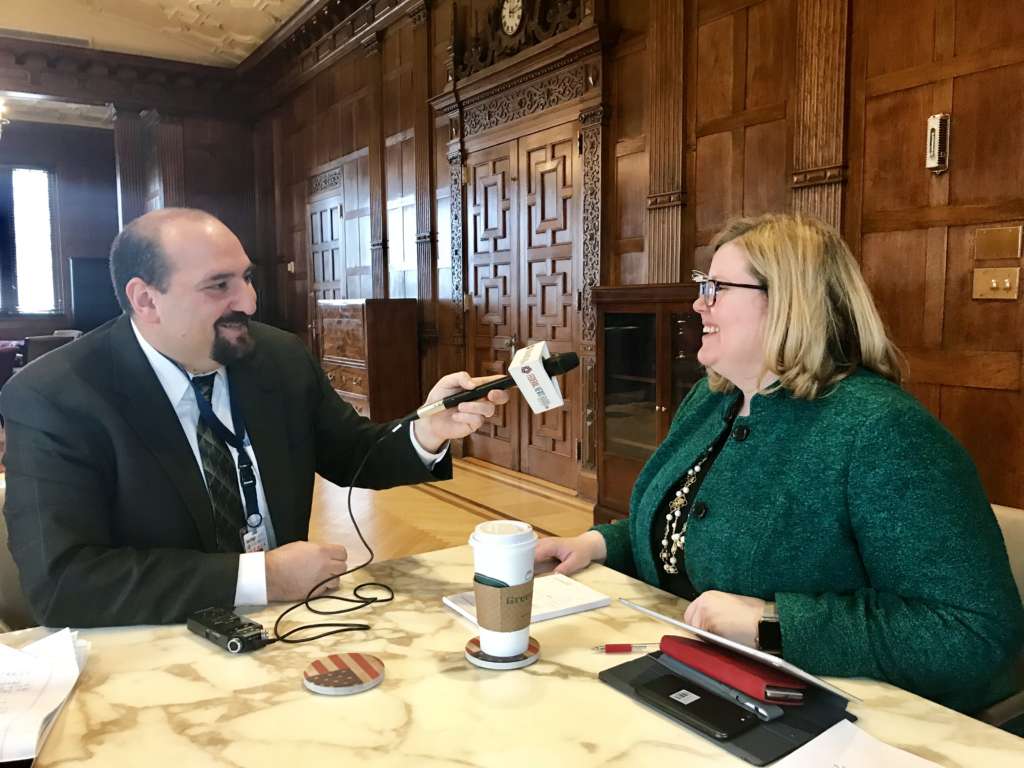

The General Services Administration Administrator Emily Murphy said customer needs and demands are the catalyst for changes to the $31 billion schedules program.
Best listening experience is on Chrome, Firefox or Safari. Subscribe to Federal Drive’s daily audio interviews on Apple Podcasts or PodcastOne.
The General Services Administration has been talking about modernizing its $31 billion schedules program for much of the last two decades. Over the next 24 months, GSA plans to finally turn all that talk into real action.
GSA announced Tuesday that it will consolidate its 24 schedules into one by the end of 2020.
GSA Administrator Emily Murphy said in a call with reporters that schedule reforms are long overdue.
“This is something both our vendors and our customers are demanding,” Murphy said. “We are looking at how customers are approaching us and the feedback we are getting from our customers. And frankly, the feedback we are getting from our vendors on the frustrations they have when they have two different contracting officers applying terms inconsistently or they have to have two different systems to deal with contract administration. It also is about our need to have our workforce work on higher valued work. If we don’t have our workforce duplicating the same efforts, collecting the same data multiple times from the same vendor, it allows them to actually work on driving the right solutions.”
Over the last 20 years, GSA has attempted both large and small improvements, but has only found limited success. The initiatives included improving the e-offer and e-modification tools, removing inactive or underperforming vendors and the modernization of FAS systems such as SAM.gov and nine other disparate databases.

The schedules consolidation initiative is part of the more recent effort by Murphy and Alan Thomas, the commissioner of the Federal Acquisition Service at GSA, to more seriously heed their customer’s concerns.
Thomas said in August GSA received more than 13,000 responses to the 2018 customer satisfaction survey.
“By consolidating the schedules, our industry partners will have a single entry point for the schedules program. They no longer will have to manage multiple schedules, which will reduce administrative costs and make their selling experience less burdensome,” Thomas said Tuesday. “Consolidating also makes it easier for our customer agencies to find and buy the right solutions to meet their mission needs. They no longer will have to buy products from one schedule and services from another.”
He said the consolidation of schedules also lets vendors sell to the federal market more similarly to how they sell in the commercial world where there isn’t an arbitrary wall between products and services.
This consolidation effort builds off a successful pilot from 2015 where GSA merged the professional services schedules.
Stephanie Shutt, the multiple awards schedule program manager, said GSA is using those lessons learned to break this bigger effort into phases.
“The first phase will be related to creating a new schedule and shutting down the existing one so that new offers only go to this new schedule,” Shutt said. “The second phase will be mass modifications to all the current contracts, to this new schedule, and updating the terms and conditions. These contractors will keep their same contract number so that will not change and they will not have to get a new contract. And then when it comes to the actual consolidation for those contractors who have multiple contracts, we will provide industry with a couple of options so we can figure out what works best for each industry partner.”
A third phase will be continuous improvements of the schedules program to include technology and processes.
Shutt explained the consolidation effort in a short video sent out to staff internally on Tuesday.
Thomas said all of this will be done over the next 24 months so GSA expects to complete the schedule consolidation by the end of 2020.
In all, GSA expects this consolidation to reduce the number of total contracts from about 17,000 to 15,000.
GSA will hold an industry day on Dec. 12 in Washington, D.C. to discuss this initiative and other changes coming to the schedules program.
Reaction to this initiative from industry has been positive and cautiously optimistic.
Roger Waldron, the president of the Coalition for Government Procurement, called it a win-win-win for GSA, customer agencies and industry.
“All three will gain efficiencies and GSA will address the inconsistencies in the program while also creating greater access to commercial solutions,” he said. “People buy solutions that include products and services all the time so being able to combine that in a single transaction instead of having to go through multiple contracts is an important change. This will address the artificial scope determinations, and it will bring the schedule further to reflect the commercial market where there are not artificial barriers between contracts. It makes the schedules more flexible and easy to use for customer agencies.”
Alan Chvotkin, executive vice president and counsel of the Professional Services Council, said in a release that the consolidation effort is a logical evolution for GSA and the schedules program.
“There may be some bumps along the road, but when this process is complete, it should be a win-win for government and industry and make for a more efficient federal acquisition experience,” he said. “We look forward to working with GSA during the implementation, just as we did when the professional services schedule was consolidated in 2015.”
Larry Allen, president of Allen Federal Business Partners and a long-time GSA expert, said in a release that it will be incumbent on GSA to ensure they organize and promote the consolidation effort in a clear, user-friendly manner.


 Exclusive
Exclusive Waldron added that communication will be important for GSA over the next two years. He said when GSA tried to create a corporate schedule in the late 1990s as a consolidation effort, the initiative failed because there were too many internal hurdles.
But part of the problem back then was how GSA was organized.
“With this management team in place with Emily, Alan and Stephanie, there is a high degree of confidence that they understand both the external and internal challenges and will tackle them head on,” Waldron said. “Their big challenge will be to keep it simple and straightforward. The changes have to be easily understood and relatively easy to implement.”
Shutt added that previous attempts ran into some obstacles that couldn’t be overcome. So this time, she led a working group that talked to contracting officers who went through the original consolidation effort about why the effort failed.
“A lot of it was the technology. We had paper contracts back then and dealing with paper contracts was a big deterrent to doing the consolidation and basically we had one contracting officer for one contract,” she said. “Right now, we have that timing and the technology so we are at the point where we could actually make this happen.”
Copyright © 2025 Federal News Network. All rights reserved. This website is not intended for users located within the European Economic Area.
Jason Miller is executive editor of Federal News Network and directs news coverage on the people, policy and programs of the federal government.
Follow @jmillerWFED
